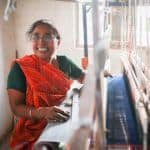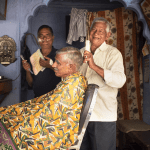Chronic, Not Acute: The Refugee Crisis Needs Long-Term Solutions – And Social Enterprise Can Help
If you break your arm or suffer a heart attack, hospital emergency rooms are the place to go. They exist to treat acute medical emergencies. But if you have a chronic medical condition, the ER can’t really help you.
Miller Center for Social Entrepreneurship believes there is a need to exert the same level of discernment toward the plight of the estimated 68.5 million people globally, including 25.4 million refugees, who have been forced to flee their homes – plus the additional 40.3 million people held in modern slavery.
It’s time to stop treating the issues of refugees, migrants and human trafficking survivors like acute emergencies and start addressing them with long-term solutions.
Recognizing the Long-Term Reality
People forcibly displaced from their homes and communities face heartbreaking challenges — whether they were displaced by war or other violence, fears of persecution or environmental catastrophes such as famine, lack of potable water or land made uninhabitable due to climate change. And these challenges are not quickly resolved: In their book “Refuge,” authors Alexander Betts and Paul Collier report that the average stay in a refugee camp worldwide is 17 years. Because the conditions that forced people to flee their homes often remain in place, the displacement for many people is permanent.
Short-term humanitarian aid — analogous to the ER for medical conditions — is not well-suited to handle the long-term needs of the world’s growing numbers of refugees, migrants and human trafficking survivors. Neither are the top-down policies and systems architected to address acute displacement after World War II.
As a pioneer and leading accelerator for enterprises that address the UN Sustainable Development Goals (SDGs), we at Miller Center decided to explore whether applying the principles of social entrepreneurship could help these vulnerable populations. Last year, we ran what we believe is the first-ever accelerator program devoted exclusively to social enterprises that serve or are led by refugees, migrants or human trafficking survivors.
We are encouraged by the results of this Social Entrepreneurship at the Margins accelerator program, and inspired by the social entrepreneurs who participated.
Lessons Learned from the SEM Accelerator Program
Miller Center’s SEM program shares the same fundamental structure as our other Global Social Benefit Institute (GSBI®) programs: training, mentoring and bringing together global social enterprise leaders with Silicon Valley business executives, student fellows and funders. For the first SEM cohort, executive-level Silicon Valley mentors accompanied the participating entrepreneurs through six months of online learning, covering topics such as business models, unit economics, impact models and growth strategies.
The SEM accelerator program culminated in a five-day in-residence workshop, including a showcase event in San Francisco at which 18 graduating social enterprises each shared a six-minute overview of their work. Participants also had opportunities to meet potential partners and impact investors at the influential SOCAP (Social Capital Markets) conference.
While a single successful accelerator program doesn’t entitle us to make sweeping claims, we learned some important lessons about the special challenges facing refugees, migrants and human trafficking survivors – and the role that social entrepreneurship might play in addressing them. Here are some of the highlights:
1. Social enterprise models are supporting refugees, migrants and human trafficking survivors throughout their journeys.
This support is available in their original homes and communities, as they’re resettled internally or in regions proximal to their own; and even if they’re living in more far-flung countries. Each stage of this journey poses its own challenges — and its own opportunities. Some example enterprises from the SEM cohort include:
- In Asia, Destiny Reflection employs human trafficking survivors to make fashion accessories to sell to ethical businesses, while also preventing re-trafficking through safe accommodation, education and social care to young, vulnerable survivors.
- African Entrepreneur Collective helps African entrepreneurs, including refugees in Rwanda, to build their skills, expand their networks and grow their businesses.
- The Five One Labs startup incubator in Iraq provides intensive training, mentorship, community and seed funding to help internally displaced refugee entrepreneurs to launch and grow their businesses.
- refugees{code} trains refugees to code and learn software development skills to help them integrate into the job market in Austria.
2. Business models that train and/or employ displaced people with dignified work are highly replicable.
One of the many successful graduates of the Miller Center SEM program is 1951 Coffee Company, a Berkeley, California-based non-profit specialty coffee organization. As a result of participating in the SEM program, 1951 Coffee Company:
- Strengthened and clarified its business plan;
- Forged ties with relevant Miller Center mentors — including Louis Jordan, the former senior vice president of global finance for Starbucks — who helped them see the bigger picture of their business and the possibilities for scaling more rapidly across the United States;
- Showcased their company to potential investors;
- Received a $200,000 commitment from the Chao Foundation to open a 1951 Coffee Company outpost in San Jose, California
- Opened two additional coffee shops, thus increasing its impact by employing more refugees.
3. Models that use technology platforms to provide urgently needed services have the potential for significant scale.
Examples from the SEM program include Leaf Global Fintech which offers blockchain-based financial services that enable refugees and migrants to secure their financial assets as they cross borders; Zero Trafficking, which provides AI-based enterprise solutions for threats related to human trafficking, and generates actionable information to save lives when minutes matter; and NeedsList, an online marketplace that matches products and services from private-sector companies with real needs from local communities around the world.
4. The new hosts for refugees and migrants need support, too.
Receiving large numbers of new and needy residents can quickly overwhelm host cities and countries. One SEM program graduate addressing the needs of host countries is Talent Beyond Boundaries (TBB) which connects refugees to international job opportunities. TBB is pioneering labor mobility as a complementary solution to traditional refugee resettlement programs by enabling the private sector to recruit international refugees out of over-burdened host countries.
5. Accelerators like the Miller Center SEM program can provide a viable piece of “connective tissue” for the systems supporting refugees, migrants and human trafficking survivors.
As social enterprises in this emergent sector become more business-capable and investment-ready, they can scale their impact. We can strengthen the networks that allow social entrepreneurs to learn from what others have done. And we can help to bridge the gap between the funding needs of social entrepreneurs — which mostly fall in the $250,000 to $500,000 range — and the risk, return and other deal requirements of potential investors, which sometimes make impact investors reluctant to do deals of less than about $2 million.
Let’s Do It Again!
Miller Center invites social enterprises serving or led by refugees, migrants and human trafficking survivors to apply for our second Social Entrepreneurship at the Margins (SEM 2) accelerator program.
By participating in SEM 2, entrepreneurs can expect to sharpen their business plans, gain insight into how to best scale impact, and become investment-ready. The six-month SEM 2 online accelerator program includes mentoring by Silicon Valley executives and is offered at no charge to selected enterprises.
The call for SEM 2 applications is worldwide, and applications are open until August 23, 2019. We particularly encourage enterprises with impact in Asia to apply. Finalists will be notified in September, and the program will commence in October.
The insistent and growing needs of the world’s refugees, migrants and human trafficking survivors demand that we find patient, long-term solutions — ones that treat the issues like a chronic crisis, not an acute emergency. We look forward to exploring new ways social entrepreneurship can contribute to those solutions.
Thane Kreiner is executive director of Miller Center for Social Entrepreneurship at Santa Clara University.
Photo courtesy of Tim Mossholder.
- Categories
- Investing, Social Enterprise



